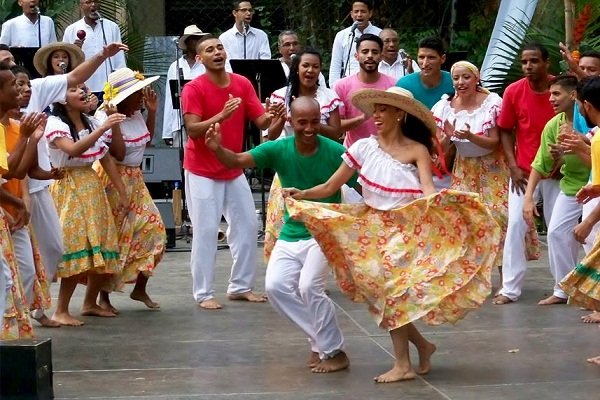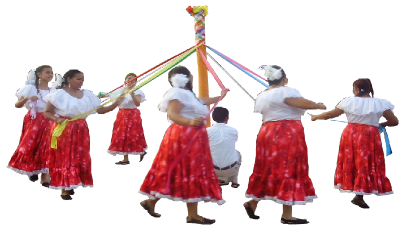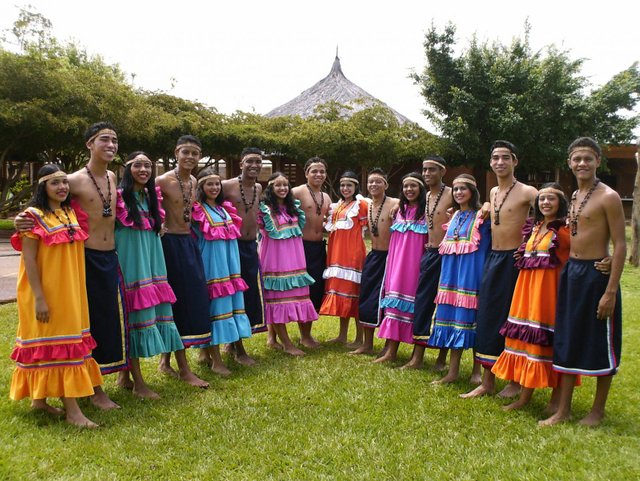ADSactly Folklore:Traditional dances of Venezuela - I

link
I like to enjoy the folkloric dances, since they transmit and give to know the origin of a town or region, its history and idiosyncrasy. Their custom and execution are transmitted to successive generations, that is why those who practice this culturals manifestations faithfully are concerned not to alter what it mean, without changing the way to execute it.
The dances in each region are different, vary according to culture and traditions, so we can say that it is a fairly diverse field artistic. No have no specific structure or order, which means in some way that this type of movement artistic is intrinsical of the identity of the population in which it is.
Through dance, one can express feelings, sensations, beliefs and traditions of the people and of the regions where they are manifested. can tell stories, poems and songs that identify them, and in this way spread the culture of the region. It should be noted that these dances are picturesque, and in they the charisma of the dancers prevails. Below is a brief summary of several of them.
The Sebucan
Also known as "the ribbons stick", this traditional dance is characterized by its diversity of colors and accuracy in its execution. it should be noted that has its origin in Europe where it bears the name of "the dance of the May Wood". Despite being considered a cultural icon of the nation venezuelan, its practice is carried out throughout America hispan as a result of European colonization of the continent. However, in Venezuela the indigenous and African influence caused modifications specifically in the music that accompanies it.
We emphasize that its name, "Sebucan", given in the east of the country, is the product of the weaving association of a utensil bearing the same name and is used to drain the cyanide of yucca when preparing the cassava bread
.
It is important to note that the choreography must be done correctly to achieve the fabric around the pole and then unweave the 12 ribbons that compose it.
This representation, according to some folklore experts, implies the importance of teamwork, of what can be done and undone when one wants to achieve a goal. I particularly admire those who practice this dance because it requires a lot of coordination and concentration in the weaving and unweaving of the tapes, really admirable and worthy of enjoyment.

link
"Maremare"
In the states of Anzoategui, Monagas and Bolivar one of the most deeply rooted customs of the ethnic group "Kariña" is the dance of "Maremare" performed in honor of the Virgin of Carmen. In this collective dance the members are placed in a circle, they embrace each other and, as the dance develops, they express some anecdote, verse, prayer, or event that occurred in the population. It is a song of free improvisation.
"The Maremare is a dance performed to commemorate the visit of an important person or a family member to the community, culmination of the funeral for the death of a character or family member. The death is celebrated with maremare, because the Kariñas estimates that the deceased passes in reality to better life, for that reason it is motive of celebration".His steps are very simple, since movements are made back and forth to the beat of the music. Although originally the dance was accompanied only by a flute, it is now enriched with other musical instruments such as el cuatro, las maracas and el tambor.
The dress for the ladies is extremely colorful, reflects the colors of the rainbow and resembles an indigenous tunic, called "sayal" or robe Kariña. The knights use a costume called in Kariña language "Pentú", which consists of a lining of marine blue color, and in the head they shine ribbons and necklaces made of seeds.
For the ethnicity "Kariña" the world was created by celestial heroes by means of the power of dance, thus establishing that the existence of man is a product of original dance. From there the importance of dancing, that would give, according to them continuity to human existence.
 link
linkThe Joropo of the plains
To culminate this article of the traditional dances of Venezuela in its first installment, nothing better than to close with one of the most characteristic and representative dances of this country and that identifies it anywhere in the world: the Joropo, known as Venezuelan Cultural Heritage. To the sound of traditional instruments such as the cuatro, the arpa and the maracas, inherited from our Venezuelan Indians and Spanish colonizers, the Joropo of the plains is a dance that is performed in much of Venezuela, but is native to the state of Apure.
This dance is characterized for being cheerful and amusing. In it are executed diverse steps and figures like the "valsiao", that is realized at the beginning of the dance moment in which the couples embrace and cross the space doing diverse figures and turns; the "escobillao", where face to face couples make short movements of the feet back and forth; the "zapateado" which is usually more of a male figure, where the man releases the lady and while she makes the step of the escobillao, he takes the lead by sounding his footsteps strongly with rapid advances. This dance represents a great popular festival in the country, where each region or geographical area takes its own essence for interpretation.
A cultural manifestation "is national when it is dispersed throughout a country and logically acquires characteristics specific to the different regions, because the different regions of the country, have a different social historical background and are part of the cultural diversity of Venezuela" Rafael Salazar.
It is important to note that the origins of the Joropo date back to 1700 and derives from the "fandango" Spanish, which represents the most significant songs and dances within flamenco. The joropo as dance adopted movement of the hands and turns of the waltz .
link
Finally, the traditional dances mentioned in this publication, as well as many others, were conceived and developed from the community itself, where they converge and link a diversity of local elements that identify it, such as handicrafts, gastronomy, beliefs, and others traditions that are referred to the community, are also inherited and transmitted from generation to generation. Knowing about dances folklore, undoubtedly, awakens love for our land and our history, and take it to future generations in formation will generate in the individual a rootedness to the traditions of their region and its subsequent promotion.
Until the next issue.
By @luces
References
Click the coin below to join our Discord Server
)
Very cool! I’ll be honest I know zero about Latin America or its history but I’d love to visit some day and get a feel for it! Really seems like a fusion of so many cultures!
A place where the food and the women are spicey! I think that we’re are still limited in exposure to many parts of the world and cultures and if only we took the time to travel will we see that
Lol having sad that I wouldn’t mind getting down on the dance floor with some Venezuelans
of course, it is a fusion of many cultures that undoubtedly form a fundamental part of what we Venezuelans are today, gastronomy, beauty, music, cultural manifestations such as dances that tell very interesting stories, we look forward to your visit. Thank you for commenting
I love the dances and culture
Posted using Partiko Android
Thank you for your comment, good thing you liked it.
It is a work of diffusion that is worthwhile, @luces. Venezuelan folkloric dances are very rich and varied, as you indicate in your post.
Of the three that you approach, perhaps the least known, because of its eminent indigenous character, is the "maremare"; moreover, it is not as lively or agile as the other two; however, it is very beautiful. At some point I had the opportunity to see her dance in person.
Without a doubt, the tamunangue and the joropo of the plain, different from the tuyero and the oriental (or "chorus") are very vivacious and cheerful.
I will be attentive to the other deliveries you will give us. Greetings.
Thank you Jose for always being attentive, and give your excellent comments. I'm glad you liked it.
You reminded me of my school days, @lights! When I was a little girl I almost always participated in folk dances. Too bad that many of these dances have become obsolete and are only danced on traditional dates and to meet some objective. I remember that many of these dances were done in the streets, with backstage and families went out to share. It was a moment of joy and relaxation. Too bad you left the dances that come to us because of the African contribution to our culture. The drum, the movement of hips, is also part of those popular and traditional dances. Well done. Greetings.
You are right, my friend, it is unfortunate that the dissemination of these cultural manifestations has diminished a bit especially in educational institutions, unfortunately there they have downplayed it and therefore the students do not know many of them. It is important to remind students that they are who are in formation, what their origins and the cultures of which we are the product today, is an important mission that we must continue to take root in our children and youth.
I dedicate you the dance of Tambores for the third part, I promise hahaha
Hi, @adsactly!
You just got a 0.29% upvote from SteemPlus!
To get higher upvotes, earn more SteemPlus Points (SPP). On your Steemit wallet, check your SPP balance and click on "How to earn SPP?" to find out all the ways to earn.
If you're not using SteemPlus yet, please check our last posts in here to see the many ways in which SteemPlus can improve your Steem experience on Steemit and Busy.
How nice to get me with this post. The dances in Venezuela are very varied and with very colorful clothes. I love that you mentioned the "Maremare" because a collective dance, holding arms and of course everyone should do the same pace. In the Mesta de Guanipa of the Sucre State there are also people of the Kariña ethnic group and they dance Maremare.
In the case of Joropo (that not all Venezuelans know how to dance it) it is so varied by each region and that several posts can be made to describe this wonderful dance. Yolanda Moreno and the Retablo Maravillas managed to take it to international stages and now many groups with great talent also do it, such as the Agrupación Cruz Alejandro Quinal (Cumanacoa) and the Mariquitar (de Marigüitar) group. Thank you very much for making this great review of traditional Venezuelan dances. Greetings @luces
It is true, the joropo is very extensive, no doubt several publications could be made just to talk about this wonderful dance (I would love to learn how to dance it). I'm glad you liked it, I hope to see your comment in the second part. Greetings.
Insurance. I will be pending
Very informative post. I remember dancing all these dances at school for some cultur@l celebration. It's a pity that some of those traditions are disappearing.
We also have the bailes de tambor or drums dances from our african descendants. I think that was about the only genre that was more mainstream, included as part of every party, maybe because of the possibilities it offers to party animals :)
Thank you friend for commenting, it is true what you say are traditions that have been lost but that we must make the effort to rescue. The dance of drums soon...
I love to dance, and I love this post.
For the ethnicity "Kariña" the world was created by celestial heroes by means of the power of dance,
This reminds me that I once heard someone (not a nice person) that when civilizations start dancing, the end of that civilization is near. But the Karina saw dance as at the beginning. Creation is a dance.
I also am very happy that the posts this week seem to be largely about Venezuela. We in the US only hear bad news from Venezuela, which makes us think the Venezuelans are poor, starving, trapped and afraid. I am so happy to have these joyful posts of the cultural traditions to learn from.
Thanks for the work that went into this post @luces. I really enjoyed it.
I love your comment, our country has a lot to show its richness, beauty and culture...we will get ahead, for now we have to show what we are. I'm glad you enjoyed it.